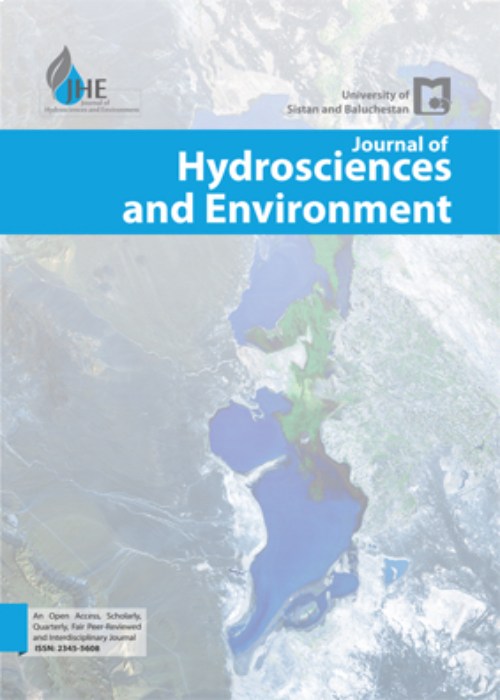فهرست مطالب
Journal of Hydrosciences and Environment
Volume:6 Issue: 12, Dec 2022
- تاریخ انتشار: 1402/08/20
- تعداد عناوین: 4
-
Pages 1-6Drinking water containing heavy metals above the maximum permissible limits cause potential risk to human health. The aim of this study was to investigate the heavy metals concentrations in groundwater to prevent the risk on the public health and assess the heavy metal pollution index (HPI, HEI) for water supply quality within the Sirjan plain in Iran. For this purpose, groundwater samples were taken from 22 exploitation wells and concentration of heavy metals including As, Cd, Fe, Al, Se, Mo, Ba and V analyzed by Inductively Coupled Plasma-Mass Spectrometry (ICP- MS) in June 2017. The results showed a HEI values determined for the groundwater samples collected in the Sirjan Plain region all indicated a low degree of pollution. While, the HPI values in the Sirjan Plain region indicated a medium and high degree of pollution. These results can be taken into consideration in planning for the management of water source polluting factors in order to provide safe water in the region.Keywords: HEI, HPI, Groundwater, Pollution, Heavy metals
-
Pages 7-19Predicting the behavior of fluid flow through the porous media is significantly important, especially in arid and semi-arid regions. In the present research, a novel numerical model based on the Implicit Differential Quadrature Method (IDQM) was developed to simulate the two-dimensional groundwater flow problems with the nonlinear Boussinesq equation. The data of the grid points were calculated from Chebyshev–Gauss–Lobatto formula. To evaluate the accuracy and the efficiency of the suggested model, three commonly reported in the literature groundwater problems were employed: (i) a problem related to the Boussinesq equation with an analytical solution, (ii) a hypothetical case of groundwater flow problem in a confined aquifer, and (iii) an aquifer pumping test. In addition, the results of the above-mentioned model were compared with the numerical predictions of the explicit and implicit schemes of the finite difference method (EFDM and IFDM). The findings demonstrated high accuracy, efficiency, and superiority of the numerical results of the IDQM. According to the results, the lowest values of root mean square error (RMSE) in the first, second, and third test cases with a range of (2.83E-23-5.65E-12), (0.072-0.065), and (0.230-0.100) were observed using IDQM. The values of dimensionless differences (DD) were also assigned the lowest values in this method in all tests. Briefly, the IDQM using less number of nodes provided more accurate results than EFDM and IFDM and as a result, is applicable to a wide range of problems in numerous fields of science and engineering.Keywords: Aquifer, Boussinesq equation, Finite difference method, Fluid flow
-
Pages 20-23The integration of urban services is one of the most important achievements of the urban geographic information system (GIS), which will clarify, unify and facilitate services by creating a database in GIS, and it will be a step in the direction of reaching the urban information management system and decision support of senior city managers, which can be used as a new and powerful tool for better city management. Gathering information (spatial and descriptive) of all aspects of green space in the region, elements, furniture and urban facilities in Qochan city is one of the main operations to achieve better management in the region. Using Quick Bird satellite images and evaluating the potential of these data in producing a number of green space information layers such as linear, point and surface complications and the ability to update area information is one of the activities that makes it easy for managers to access information.Keywords: SWAT, calibration, Validation, Water yield
-
Pages 24-30
A two-dimensional model was developed for the decomposition of petroleum hydrocarbons by local microorganisms under the conditions of nitrate reduction (denitrification). To apply this model, a group of anaerobic mobile microbes with low concentration in the environment was considered. Therefore, after this time, there will be no leakage from the ground surface. The model was implemented with the assumption that the sources of pollution will be removed from the surface of the earth after 36 years. Also, it is assumed that the microbial population is not absorbed into the solid phase of the aquarium environment and nitrate is the only electron acceptor in the environment. Numerical solutions were obtained using the finite volume method. The results showed that the concentration of petroleum hydrocarbons in some areas of the site is higher than the standard, which can cause health risks. In addition, the results of field studies showed that nitrogen accumulation in the soil of Ray Industrial Area and Tehran Oil Refining Company is high. This issue shows that the natural dilution processes alone are not able to completely clean the studied site from oil pollution, and for the complete cleaning of the water system, a suitable improvement strategy should be considered. To be designed according to the conditions of the site.
Keywords: Modeling, petroleum hydrocarbons, Nitrate reduction, microorganisms


